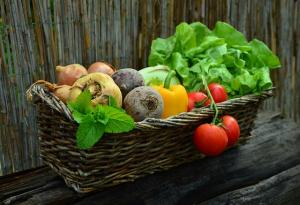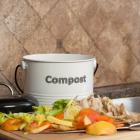What's the environmental impact of growing your own food?
Submitted by Johanna Nagy on | Updated Sat, 17/09/2016 - 23:49

Buying locally grown food is a great way to minimize your environmental impact, and growing your own food takes that idea one step further. You might be surprised by the effect even a small vegetable garden can have on your carbon footprint. Here’s a simple calculation to show just how much energy you might be able save with your garden.
The first step is to calculate the typical energy cost associated with transporting food. It has been estimated that produce travels an average distance of 1500 miles before it is consumed [1]. Agricultural products are one of the top two commodities transported by semi-truck in the US, and a typical semi-truck gets about 5.6 miles per gallon of diesel while carrying 34,000 pounds of cargo [2,3]. Each gallon of diesel it burns releases 22.38 pounds of carbon dioxide into the atmosphere [4]. Based on these numbers, each pound of food releases 0.18 pounds of CO2 into the atmosphere from transportation alone! Stated another way, the energy associated with transporting a 5.2 ounce serving of broccoli is equivalent to 90.3 nutritional calories, even though it only provides 50 nutritional calories of energy when it is consumed [5].
Of course, many of the readers of this blog are probably more eco-conscious than the average person and may already be buying local produce. If your produce travels an average distance of 150 miles, transporting one pound of food results in the emission of 0.018 pounds of CO2. You should use this number instead when calculating your own energy savings.
To figure out how many pounds of CO2 a garden can save, we need to estimate the amount of food a typical garden will produce. Based on data from Louisiana State University Ag Center, one could grow 1.5 pounds of cherry tomatoes, 0.6 pounds of potatoes, or 0.5 pounds of carrots per square foot of garden space [6]. The exact yield will depend on climate and soil conditions, but these numbers provide a good starting point for our estimation, and data for many other crops can be found in the reference. In this example we calculate that with only 10 by 10 foot garden, one could grow 150 pounds of cherry tomatoes, which is the equivalent of keeping 27 pounds of CO2 out of the atmosphere. With the data from the reference, this calculation could be repeated for a garden size of your choice with a diversity of crops (just divide the numbers in the reference by 300 to get the approximate yield per square foot). Since your energy savings is directly proportional to the yield of your garden in pounds of produce, you maximize your energy savings by focusing on crops with the highest yield per pound in this simple estimation.
If you are planting your garden in a place that wasn’t already covered by plants such as a balcony or patio, you may wonder how much the extra CO2 absorption from these plants will offset your carbon footprint. It is difficult to estimate how much CO2 any given plant will absorb because this depends strongly on the environmental conditions, but a healthy tree will store about 13 pounds of CO2 in one year [7]. Since plants in a small garden will likely be much less efficient at storing CO2, their contribution to your carbon footprint is probably small compared with the savings calculated above. Although every little bit helps, this suggests that focusing on reducing direct and indirect fossil fuel consumption may be one of the fastest ways to reduce your environmental impact.
If you are thinking about starting your own garden, many websites recommended starting with small plants that grow easily in your area. Choosing crops that grow vertically is great if you are short on space. Planting crops from seeds (possibly from produce that you already buy) and using homemade compost are great ways to keep the costs low and environmental benefits high. Try to avoid synthetic fertilizers, which not only take a lot of energy to produce, but can also emit harmful greenhouse gases. Many websites, such as the Climate Friendly Gardening Guide from the Union of Concerned Scientists [8], have great tips to help you and the environment get the most out of your garden.
References
You will save the Earth by sharing and/or tweeting (corny right?)





